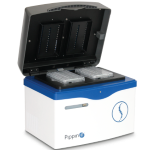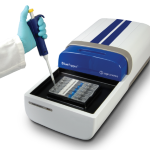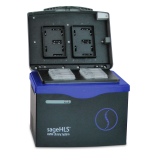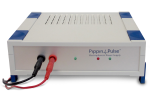BluePippin Optimized for Illumina’s Moleculo Kit
As Sage Science blog readers know, BluePippin is used throughout the genomics community for size-selecting larger fragments — we’ve gotten lots of attention for how well the tool performs with extremely long reads from the Pacific Biosciences sequencer, for example.
Now we can report that BluePippin has also been validated and optimized for use with the new Illumina TrueSeq Synthetic Long-Read DNA Library Prep Kit (TSSLR), based on the Moleculo technology.
The workflow was validated with a few different experiments. In one key project, we examined various size selection settings with the kit’s recommended DNA input (600 ng per lane) and shearing conditions. With the TSSLR team at Illumina, we agreed that a range mode of Bpstart=7,000 bp and Bpend=11,000 bp gives the best results.
In another project, we evaluated performance with different DNA input volumes. Starting with the recommended 600 ng of DNA and decreasing all the way to 100 ng, we found minimal changes in average fraction size. The TSSLR team determined that no adjustment to BluePippin settings is required for use with sample volumes as small as 100 ng.
This chart shows the results of using BluePippin with the TSSLR protocol for a low-concentration sample:
You can check out the official recommendations for using BluePippin sizing with the TSSLR kit in this prep guide from Illumina (starts on page 95).
Already working with the TSSLR kit? We’d love to hear about your experience and discuss how BluePippin sizing can improve your results. Ping us at info@sagescience.com.
7,000 Handshakes Later, We Bid Adieu to ASHG
The Sage Science crew is back in Boston, ready for some much-needed rest after a fun-filled ASHG 2014. We didn’t meet all 7,000+ attendees at the event, but we certainly gave it our best shot! Many thanks to all of the scientists who stopped by our booth to find out how something as simple as precise DNA sizing can make a real difference in data quality for next-gen sequencing results. People who did stop by got a sneak preview of a new instrument we’ll be launching soon — for the rest of you, stay tuned!
Several of the final talks of the conference focused on cancer studies, which had us particularly interested since so many of our customers use fractionation tools for this application. Whether cancer genomics is interrogated with whole-genome sequencing, targeted sequencing, RNA-seq, miRNA isolation, structural studies, or ChIP-seq, our users have published on it. (You can check out a sampling of those papers here.) The talks on cancer epigenetics, such as using methylation markers to detect tumor DNA in blood, were fascinating.
Of course, there was the usual debate about exome sequencing versus gene panels for a range of uses. We understand the need to choose one of these options now, but as ardent DNA sequencing champions, we’ve got high hopes for a time when whole-genome sequencing is affordable enough to be the no-brainer solution for every application.
Already looking forward to ASHG 2015 in Baltimore!
At ASHG, the Big Picture Is Big Studies
Here at ASHG 2014, we’ve taken a moment to step back and look at the bigger picture for the narrative tying together the top-notch presentations, stellar posters, and frenetic exhibit hall breaks. What we’re seeing is that, several years after the wave of genome-wide association studies first hit, scientists have learned the value of sample size in the study power equation.
You can’t swing a free T shirt in the exhibit hall without hitting a scientist actively working on a massive-scale study — and by that, we mean anything including tens of thousands of people or more. (The Million Veteran Program was the topic of one talk we enjoyed.) Whether they’re analyzing exomes, whole genomes, or just targeted genomic regions, the projects are bigger than ever. It’s a trend we’re thrilled to see, and one that leaders in the field have spent years calling for.
Clearly, this is due to the precipitous drop in the cost of DNA sequencing. (And from what we’re witnessing here, it’s safe to say that cost is only going to keep dropping.) The fact that regular scientists in regular labs — not just the best-funded, world-class genome institutes — are embarking on studies like this is a real testament to the democratization of this technology. We’re proud that our own sample prep instruments play an important role in making these NGS workflows reliable, robust, and inexpensive.
Of course, all of this new data puts tremendous pressure on analysis. We’ve heard about lots of open-source tools and commercial solutions for data interpretation, but there have been some creative approaches presented as well. In one talk, Andrew Su from the Scripps Research Institute spoke about a crowdsourcing method using citizen scientists — people interested in the field but who lack the usual PhD credentials — to annotate and curate scientific literature. Su told attendees that by gathering enough annotations from non-experts, he was able to get results at least as good as if he’d hired a PhD scientist to perform the annotation.
We can’t believe ASHG is already half over. If you haven’t heard about the Sage Science products yet and how they can simplify your NGS library prep, please swing by our booth (#935). We’d love to meet you.
Dispatches from San Diego: ASHG 2014
The first day of ASHG 2014 has been a whirlwind of great science, engaging talks, and (of course) the inevitable zany environment of the exhibit hall. Attendees are swarming Oxford Nanopore’s booth, where representatives are apparently sequencing samples on-site.
Last night’s presentation of the Gruber prize for work with small, noncoding RNAs to Gary Ruvkun, Victor Ambros, and David Baulcombe provided attendees with a bird’s-eye view of this important area of research. Baulcombe noted that the association of small RNAs and epigenetics gives even more reason to study epigenetics in major research studies.
Other awardees honored today offered insight into how the greats approach science. David Valle, winner of the Victor A. McKusick Leadership Award, reminded attendees to be rigorous about what they know as well as what they don’t know — and to be open to change when new knowledge is available. The University of Michigan’s Gonçalo Abecasis, who won the Curt Stern Award with Mark Daly from the Broad, urged his fellow scientists to be fascinated by new ideas. “One person and a good idea can make a difference,” he said. He also cautioned people against placing too much importance on results that haven’t been properly interpreting, saying that data is not the same as understanding, and tools are not analyses.
This morning, ASHGers were treated to a remarkable presentation from Konrad Karczewski, a postdoc in David MacArthur’s lab at Massachusetts General Hospital and the Broad Institute. Karczewski spoke about the human knockout project, a sweeping effort to find loss-of-function variants in humans. These knockouts occur naturally in all people, but certain LoF variants might be used to guide pharmaceutical development if they can be properly linked with phenotypes, Karczewski told attendees. He presented a new analysis tool called LOFTEE and talked about new mechanisms his team has found, such as splice-creating variants, novel start codons, and more. MacArthur’s lab has been conducting a massive exome analysis project, providing ample data for the LoF study, and variants from 63,000 exomes will be released by the lab today.
Like many ASHG attendees, we’ve noticed the prominence of genomics at this genetics meeting. Big data has been a watchword for many here — in one session, representatives from Google and IBM spoke about the need to ramp up data analysis as large new studies are conducted and reported all the time — and we are glad to see the emphasis on high-quality bioinformatics.
We look forward to updating readers again as ASHG 2014 continues!
ASHG 2014: See You in San Diego!
We can’t wait for the annual conference for the American Society of Human Genetics in San Diego this weekend! Five days of back-to-back scientific sessions, 6,500 attendees, countless parties — it’s a great opportunity to geek out on genomics.
While the scientific presentations are always top-notch, we think ASHG stands out for the big-picture talks given by various awardees. This year’s talks surely won’t disappoint. Award winners include Victor Ambros, David Baulcombe, Gary Ruvkun, David Valle, Mark Daly, and Gonçalo Abecasis, among others. We look forward to hearing their take on the human genetics field and where it’s heading.
If you’re not familiar with the Sage Science portfolio of automated DNA size selection and fractionation products, you can get a great glimpse of one of our instruments in action in a poster from scientists at Cold Spring Harbor Laboratory. Poster #1617S (presented Sunday, October 19, 4:00 pm – 5:00 pm) is entitled “Greatly improved de novo assemblies of eukaryotic genomes using PacBio long read sequencing.” In it, researchers pair our BluePippin instrument with a Pacific Biosciences sequencer to optimize read lengths, achieving reads up to 35,000 bases.
We’ll also have BluePippin, Pippin Prep, and our new SageELF on display at our booth (#935), so please stop by. Our team would be happy to share data on how accurate and reproducible sizing can generate better sequence data, and do so more efficiently, than other sizing methods. We hope to see you there.






